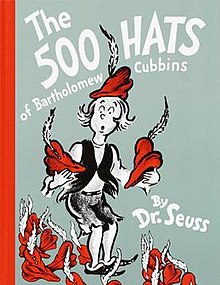The 500 Hats of Bartholomew Cubbins: Difference between revisions
m Dating maintenance tags: {{Failed verification}} |
Rescuing 1 sources and tagging 0 as dead. #IABot (v1.6.1) (Balon Greyjoy) |
||
| Line 45: | Line 45: | ||
==External links== |
==External links== |
||
*[http://www.kiddierecords.com/week_24/sleeve_inside.htm RCA Victor: ''The 500 Hats of Bartholomew Cubbins''] |
*[https://web.archive.org/web/20080331030625/http://www.kiddierecords.com/week_24/sleeve_inside.htm RCA Victor: ''The 500 Hats of Bartholomew Cubbins''] |
||
*[http://www.drseussart.com/hatsoff/ "Hats Off to Dr. Seuss"] |
*[http://www.drseussart.com/hatsoff/ "Hats Off to Dr. Seuss"] |
||
Revision as of 12:25, 24 December 2017
 | |
| Author | Dr. Seuss |
|---|---|
| Cover artist | Dr. Seuss |
| Language | English |
| Genre | Children's literature |
| Publisher | Vanguard Press |
Publication date | September 1, 1938 (renewed 1965) |
| Publication place | United States |
| Media type | Print (Hardcover) |
| OCLC | 192190 |
| Preceded by | And to Think That I Saw It on Mulberry Street |
| Followed by | The King's Stilts |
The 500 Hats of Bartholomew Cubbins is a children's book, written and illustrated by Theodor Geisel under the pen name Dr. Seuss and published by Vanguard Press in 1938. Unlike the majority of Geisel's books, it is written in prose rather than rhyming and metered verse. Geisel, who collected hats, got the idea for the story on a commuter train from New York to New England while he was sitting behind a businessman wearing a hat; the passenger was so stiff and formal that Geisel idly wondered what would happen if Geisel took his hat and threw it out the window. Geisel concluded that the man was so "stuffy" he would just grow a new one.
Plot summary
Set in feudal times, the story begins in the Kingdom of Didd, when King Derwin is riding through a street past peasant protagonist Bartholomew Cubbins. Ordered to remove his hat, according to the laws, Bartholomew does so, but another hat mysteriously appears; when he attempts to remove this one, yet another one appears; as this continues, the hats begin to grow in extravagance and beauty from the 451st hat onwards. Ultimately the 500th hat, studded with massive gems and gilding, leaves Bartholomew's head bare. Stunned by the beauty of the hat, King Derwin grants him reprieve and trades him 500 gold coins for the 500th hat.
Reception
The book received positive reviews from critics. The New York Times reviewer called the book "a lovely bit of tomfoolery which keeps up the suspense and surprise until the end."[1] Booklist, which had criticized Geisel's previous book, And to Think That I Saw It on Mulberry Street, for containing only enough material for one comic strip, praised The 500 Hats as "a brand-new idea, developed into a complete tale, not too long, not too short, just right. Somewhere between the Sunday supplements and the Brothers Grimm, Dr. Seuss has produced a picture book combining features of both."[1] Alexander Laing, who had worked with Geisel on the Dartmouth Jack-O-Lantern humor magazine, wrote in his review of the book in the Dartmouth Alumni Magazine, "His several other occupations, madly fascinating as they are, may have been only preludes to a discovery of his proper vocation. That he is a rare and loopy genius has been common knowledge from an early epoch of his undergrad troubles. It now becomes plain that his is the self-consistent, happy madness beloved by children. I do not see what is to prevent him from becoming the Grimm of our times."[1]
Adaptations
- Not long after publication, the story was adapted for an album issued by RCA Victor (Y-339). Narrated by Paul Wing, the audio adaptation had a running time of 13 minutes and 37 seconds. The dramatization featured music and sound effects on two 10" 78rpm records in a bi-fold sleeve. This recording was played in elementary school classrooms during the early 1940s.
- Geisel wrote the script for the 1943 puppetoon short of the same name for Paramount Pictures, which was produced by George Pal. It also received an Academy Award nomination for Best Short (Cartoon).[2][3] Unlike the book's illustrations, in which Cubbins' hats were all the same one, the hats in the film were of many different kinds.
- Minnesota's Children's Theatre Company, the only youth theatre company to ever win the coveted regional Tony Award, is the only theater company in the world with the rights to perform The 500 Hats of Bartholomew Cubbins on stage. The company has produced it nearly a dozen times since Theodor Geisel and his estate provided Children's Theatre with the rights. The company has toured the play across the United States, in China, Russia and Japan. The last time the company produced the play was to sold-out houses in 2010 at their Minneapolis home.[4][failed verification]
Sequel
The characters of Bartholomew and King Derwin returned a decade later in Bartholomew and the Oobleck.
Notes
References
- Morgan, Neil; Morgan, Judith Giles (1996). Dr. Seuss Mr. Geisel: A Biography. New York: Da Capo Press. ISBN 978-0-306-80736-7.
